The Saturday Evening Post’s Duluth of 1949
Seventy years ago — April 16, 1949 — Duluth was featured in The Saturday Evening Post as part of the magazine’s series on “America’s most colorful cities.” The lengthy article by Arthur W. Baum was the 65th in the series, and features photographs by Frank Ross.
The intro text reads: “Once a bleakly unpromising village, this now great grain and ore center has survived many a stunning setback — thereby making her smart-aleck detractors look foolish. The cheif hazard of life here is this: You never know when a wild bear will drop in for breakfast.”
DULUTH
By Arthur W. Baum
The citizens of nearly every hub city, or zenith city, or queen city must sometimes be upset by the outsider’s inability to understand the importance of their community in the cosmic scheme. No matter how carefully chamber-of-commerce charts and circles prove that Los Angeles or Dallas or Springfield is the very dead center of everything, the universal disbelief of strangers beyond the city limits must produce uneasiness. Which makes the case of apple-cheeked, blue-eyed, tow-haired Duluth, third city of Minnesota, unique.
For Duluth has not had to worry about outside acknowledgment of its spot on the globe since January 27, 1871. On that day an obvious stranger, Rep. J. Proctor Knott, of Kentucky, announced in Congress that Duluth was “pre-eminently a central place.” Said Knott, “Duluth is … so exactly in the center of the visible universe that: the sky comes down at precisely the same distance all around it.” This backhanded crack was delivered in one of the greatest satirical speeches ever heard in Congress, one in which Proctor Knott, attempting to block the grant of lands for a railroad into the Duluth area, flayed the infant city so witheringly that Congress extended its session to hear a few more bits of skin ripped off. It does not disturb Duluth in the least. Proctor Knott was proved so wrong, so often and so soon, that Duluth soberly regards every barb he threw as a serious prophecy. The city not only forgave him but later entertained him while he viewed his errors on the spot, and named a suburban community after him.
To be a little more precise than the Kentuckian, the city of Duluth lies at the most westerly point of the largest unsalted sea in the world, Lake Superior — a fluid deity which the city worships to a man. At every season of the year the sun rises on Duluth over the cold blue water or the gray ice of this inland sea, so vast that it has little tides. Hiawatha called it “Gitche Gumee, the shining Big-Sea-Water.” At its sharp western nose, where it is fed by the St. Louis River, is the very headwater of all the Great Lakes, 603 feet above the ocean. Up the middle of the bay of the St. Louis and up the river for a way, the states of Minnesota and Wisconsin border each other.
Some of the oldest known rock on earth rears up on the north, or Minnesota, side of the bay, river and lake. For some unaccountable reason, Duluth has plastered itself against this rocky bluff with only a spatter of beach and a couple of sandspits for footing. It is consequently a long, skinny city, a sort of rip-saw blade with smooth edge to the water and teeth sticking up into the rocks wherever it finds a grudging crevice. Like the dachshund, Duluth is a city and a half long and a tenth of a city wide. Twenty-six miles from one end to the other, its average width is only one-tenth its length, yet it covers more area than Boston, St. Louis or Pittsburgh.
Across the river and inner bay behind a nine-mile sandbar there is a perfectly logical place for a city. In fact, one is there — Superior, Wisconsin. That Duluth, rather than develop in comfort on the grassy flats where Superior lies, chose to buck the unlikely cliffs on the north shore is quite in character. Duluth’s history is a long series of counterpunches at circumstances and events. When Duluth wins a round, it habitually comes up off the canvas to do it.
Placed originally on the wrong side of the river, it was the least promising of six villages. It engulfed them all. Ridiculed before the nation by Proctor Knott, it heard him recant fully. Failing flatly as a city on its first try, it had to start all over again more than a decade later. The gold and copper it hoped to find in its hinterland were elsewhere, and it had to settle for mere timber. But in taking the timber it stumbled upon a whole destiny in iron. And with the world’s greatest iron deposit, the miraculous Mesabi Range, in Duluth hands, the local ownership was promptly lost to Easterners.
She’s down, she’s up. The iron that made Duluth, after a half century gave warning of coming exhaustion and promised to unmake it, and just at this critical point the late war squeezed the Mesabi harder instead of less hard. The Lake Superior iron ranges had to provide 80 per cent of the steel thrown into the war by the United States, which was most of the Allies’ steel. But in the shadow of this tragic depletion Duluth has now discovered a possible new century of hope in abundant lower-grade ore. If techniques for handling the leaner ore improve just enough, great beneficiating plants and increased pay rolls may appear in the iron ranges for which Duluth is supplier, outlet and shopping center.
By surviving this continuous stream of stumbles and recoveries over almost eight decades, Duluth has reached a population of about 105,000, achieved a firm industrial underpinning, captured a huge tourist business — including a large bloc of the nation’s hay fever sufferers — and has built a port whose annual tonnage is second in America, exceeded only by New York.
The port is actually that of Duluth-Superior, sometimes called Twin Ports or Head-of-Lakes. Duluth often uses the double name, though not always, and gladly includes the traffic tonnages of its junior across the bay when bragging on the size or merits of the combined port. On all other occasions it is capable of blandly ignoring the very existence of Superior, which has a population more than a third the size of Duluth’s.
Any harbor that moves sixty-odd million tons a year is a remarkable port. But Duluth does it with only eight months of navigation, spending four, months a year ice-bound. As a bulk-commodity port 98 percent of tonnage is bulk. Duluth-Superior is doubtless unmatched in importance anywhere. It moves more than half of all Lake Superior iron ore, the chief sustenance of Pittsburgh, Cleveland, and Chicago-Gary steel, the steel heart of America.
Mechanized to its teeth, Duluth’s waterfront pours twenty or more tons of iron ore into 600-foot lake vessels for every ton of anything else. Yet more of its waterfront is occupied by rows of stately concrete grain elevators than by ore docks, and the value of the grain it handles is not far behind that of its ore. Only three American cities exceed its 50,000,000 bushels of storage capacity, and it is the chief handler of the Northwest’s spring wheat, flaxseed and the macaroni wheat, durum.
Coal, ore, grain and eight railroads coming into the harbor give Duluth a thoroughly industrial face, and properly so. But directly across the thin civic torso — at times narrower than a mile — the city turns so wild that the body of a suicide within the city limits once remained undiscovered for three years. And in 1918 a tragic forest fire swept through the city’s decorative upper fringe of aspens, birch and pines, burned out the Northland Country Club and almost reached the waterfront. Across this upland border wild animals frequently enter town.
Slightly embarrassed by the uncivilized implications of its wild-animal affairs, Duluth yet relishes the distinction of so intimately combining industry and commerce with an occasional whooping moose chase across residential lawns. In 1947, Duluth police answered an average of two animal alerts per day. Happily, the city’s crime is way below the national average in every category but larceny, and the police have time to rout deer from gardens and bears from garbage cans. Nor do these skirmishes between the police and fauna always occur on the fringes. Witness the morning of Sunday, August 18, 1929.
At 2:15 a.m. on that day a black bear was reported out in the east-end residential district where the high grade of table scraps in the refuse cans reflects in many cases the presence of royalties from fee land owned in the iron ranges. Undoubtedly it was the same bear, a 350-pound beauty, which somewhat later fell in behind the truck of Arvid Petersen, preceding west on Superior Street toward the center of town. In two respects the bear was thus behaving exactly like a Duluthian. First, because Petersen’s truck was full of Lake Superior fish, and all Duluthians are fond of the lake’s excellent whitefish, lake trout and wall-eyed pike, preferably planked. Second, because he was on Superior Street, the lengthwise traffic artery paralleling the water, on which everybody travels every day.
Petersen, fish and bear, in that order, eventually reached Third Avenue East — the city’s streets are atrociously named — three blocks from the mathematically central cross corner. Petersen turned here, but the bear did not. At 5:50 a.m. the bear was sighted two blocks farther west, very near the exact center of the business district. At 5:55 a.m. he had perversely turned about, retreated two blocks and was reared up against the fifteen-foot plate-glass window of the coffee shop in The Duluth, the city’s largest hotel.
It was shortly apparent that whatever the coffee shop was preparing for breakfast that morning was as good as or better than a truckload of fish, because the bear casually slapped a huge hole in the window, ambled through, and made for one of two short flights of steps, which led to the kitchen at the rear. He was met by a chair hurled by Albert Nelson, the night watchman. He tried the other flight and was again bowled over by a slung chair. It is reported that on his third try the bear was looking less interested in conventional breakfast, and extremely interested in Nelson. At that point, 6:10 a.m., Police Sergeant LeBeau, of the ursine unit, who had arrived with a rifle, dropped him. The name of the coffee shop was quickly changed to The Black Bear Lounge. The bear still presides, but mounted.
If this incident characterizes Duluth, it is not primarily because of the black bear’s beachhead in a midtown hotel, but rather because, of the five central figures in the affair, two were named Petersen — the assistant manager was O. M. Petersen — and one was named Nelson. Smiths and Joneses are infrequent in Duluth. Gustafsons, Andersons, Larsons, Hansons, Olsons and several other “sons” are prevalent. Fifteen per cent of Duluthians are native-born of Scandinavian parentage. And of the 20 per cent foreign-born in the population, more than half are Swedes, Norwegians and Finns.
Of the “sons” of Duluth, the most wonderfully numerous are the Johnsons. There are more than 700 Johnsons in the phone book alone, including the distinguished-looking Mayor George Johnson, who has a low, vibrant voice that brings the platform right into ordinary conversation. Mayor Johnson is also commissioner of parks and boulevards under Duluth’s commission form of government, and has the quite pleasant job of tending the city’s Skyline Drive, an attractive road rimming the bluff and overlooking the harbor. The mayor also has ninety parks and park areas under his jurisdiction, more recreational space than most cities twice as large ever dream of.
Mayor Johnson believes that the people of Duluth possess a marvelously co-operative spirit — a doubtful premise, since there are several cleavages along its stringy length. The main personality split in Duluth occurs about where an interfering spine of rocks comes down from the hill to Superior Street just a few blocks west of midtown. West of this point of rocks Duluth is politically left, east of it it is politically right. But there is a certain uniting force in cold weather, of which Duluth has its share. Hostile parties have been known to refer to a Duluth winter as a year, “except for that week of poor sledding,” but actually the climate is moderated by the presence of Lake Superior, and the city has never known an official winter temperature colder than a bracing forty-one degrees below zero.
This is nevertheless cool enough to afford ice skating, and neighbors everywhere join in preparing small earth-dike rinks. One of Mayor Johnson’s special examples of “the spirit of the people” is a skating rink in Duluth Heights, where community-club members built a warming house and recreation building with their own hands last fall. This illustration of co-operation has a Johnsonian sidelight, though the three people who were sponsor, president and building-committee chairman were, respectively, Mayor George Johnson, Dewey Johnson and Charles Johnson, not related.
The name Duluth, nicely adapted to the silver-bell tones of the Scandinavian tongue, is nevertheless a relic of seventeenth-century New France. The city was named for Daniel Greysolon, Sieur du Lhut, or Luth, a fur trader from Montreal who made himself favorably known at the head of the lakes in the late 1600s. The county of which Duluth is the seat is St. Louis County, larger than the states of Rhode Island and Connecticut together. Fond du Lac, site of the earliest settled fur-trading center at the mouth of the St. Louis River and birthplace of the region’s first almost white child, is now part of Duluth.
Place names like Mille Lacs and Lac La Croix, which occur mixed in with Chippewa Indian names like Kabetogama and Eshquagama, are about all the imprint the French left on the region known as the Arrowhead Country. Duluth is the capital and St. Louis County the central slice of the Arrowhead, a territory squeezed to a sort of arrowhead point between the Canadian boundary and the north shore of Lake Superior. The Arrowhead has been under eleven different sovereignties in its time, and if a story about the thrifty Benjamin Franklin is true, the whole region owes a debt to Philadelphia. Franklin, it is alleged, hearing that Isle Royale in Lake Superior, northeast of Duluth, was the site of rich Indian copper mines, shrewdly hoisted the United States boundary line to include it when he signed the post-Revolution treaty with the British, thus capturing the Arrowhead and its iron-ore ranges, including future Duluth.
Whether that is true or not, another Philadelphian, the financier Jay Cooke, certainly gave Duluth a hand up. The village had been born in 1857, only to collapse in the panic of the same year, one of its several panic flattenings. Jay Cooke boomed it into a city in 1870 by terminating a progenitor of the Great Northern Railroad there. The panic of 1873 bankrupted both Cooke and Duluth, knocking the city completely out of city status for fourteen years. It did not reincorporate until after still another Philadelphian, Charlemagne Tower, financed a railroad in 1884 to bring the first iron ore out of the Vermilion Range to the lake twenty-six miles northeast of Duluth.
Duluth at that time was scarcely interested in the iron, which was known to be present in its hinterland, preferring timber and grain. But some of the timber cruisers, notably the seven Merritts, of Duluth, looked as much for iron as for timber and thereby discovered the great Mesabi Range, source of more iron than all the other Superior deposits combined.
The Merritts were Duluthians who planned to extend their iron empire beyond the mines to include their own railroad, docks, shipping fleet and steel mills. What might have happened if they had succeeded is something Duluth can puzzle over for a long time. They did ship the first ore into Duluth in 1892, but they also borrowed extensively against their properties. Books have been written about what happened between the Merritts and John D. Rockefeller, who lent the money, but in the end Rockefeller owned the properties and the Merritts accepted a settlement which left little of their original dream. The panic of 1893, another flattening blow for Duluth, not only wounded the Merritts but nipped many of the small mining ventures that were starting on the Mesabi.
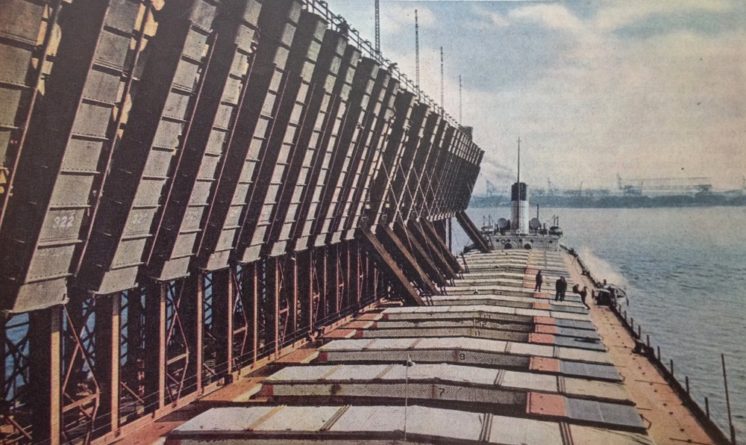
Iron ore, hauled 75 miles by train from the fabulous Mesabi Range, is loaded into the hold of a 600-foot lake vessel, where it will make its long trip down the lakes to the steel heart of America.
It is scarcely credible that in the 1890s any Duluthians or anyone else fully glimpsed the immensities which underlay their iron tradings. Timber families who sold cutover land to mining people were none too glad to get it back when buyers could not meet payments. Some of those who grumbled loudest at their failure to get rid of land containing nothing but iron are happily collecting royalties on it today.
A few dozen miles from Duluth, at Hibbing, is a hole in the ground out of which more earth has been moved than was dug in the Panama Canal. Duluth was in great part built on the work and wealth entailed in this and other open-pit and shaft iron ore from the Mesabi, Vermilion and Cuyuna ranges. But Duluth doesn’t much give the appearance of iron or see a great deal of the ore it ships. Trainloads coming down the hill move overhead on trestlework directly to the two vast docks on the Duluth side of the harbor. The railroad that hauls most of the ore — the Duluth, Missabe and Iron Range — has the highest traffic density in the country, but relatively little passenger or normal freight. And the Great Northern, second ore carrier, takes its ore to the Superior docks.
Despite its iron dominance, the city has a Middle West look and Middle West lack of eccentricities, except for topography. The largest pay roll in town is at the wire-and-rod mill of American Steel and Wire Company, but that is tucked off at one end, along the river. An unusual number of checkered wool shirts and red caps are observable on Superior Street, and store windows commonly display snowshoes along with inevitable skis, fishing gear and guns — St. Louis County is classified as 84 per cent wild land. The rolling gait of a visiting lumberjack is often seen, but the sawmills are long since gone and cool Duluth’s second-largest pay roll is, oddly enough, the Coolerator Company’s refrigerator plant.
Out on Rice’s Point, near the grain elevators and coal docks, are small frame houses, which come close to slumminess. Elsewhere the average Duluth house is squarish frame, sometimes yellow brick. The west end is less pretentious than the east end, and its Democratic-Farmer-Labor politics have overbalanced the east end Republicans for years.
Considering that a good deal of royalties from fee land in the iron ranges settles on the slopes of the east end, the houses sprawled there are not ostentatious and are indeed less padded with lawn and garden room than would be the case if Duluth were not trying to clamber up its rocky bluff.
Culture is largely a possession of the east end, and includes not only a very good St. Louis County Historical Society but the Chisholm Memorial Children’s Museum, a useful little organization which has portable exhibits that are used by the public schools. Sinclair Lewis lived in a house overlooking Congdon Park, a mining-family name which, like Crosby and Sellwood, is memorialized in the city’s street names. Lewis was a temporary resident, however. Duluth’s principal literary contribution is a native, the novelist, Margaret Culkin Banning.
The University of Minnesota maintains its only branch in the east end of Duluth, and by an odd coincidence young Doctor Raymond Gibson, president of the UM Duluth branch, comes from the original bailiwick of Proctor Knott in Kentucky. Doctor Gibson has elaborate hopes for the university branch, and so does Duluth. Only recently established, a horizon of 10,000 enrollments is glimpsed for the school, hundreds of them doubtless to be Johnsons.
A daily Finnish newspaper in Duluth gave up last year and its plant was taken over by the Labor World, which has a substantial circulation. But the main morning and afternoon newspapers are Ridder papers, which cover the port and iron-range news as a matter of course and also devote regular space to one of the city’s odd whimsies, an inordinate interest in the game of cribbage. The number of cribbage boards around town is astounding, and the presence of a near-perfect 28 hand in a tussle between two teams of the City Cribbage League is a matter for serious news report.
Taxicab rates are exceptionally high in Duluth, and there are no chain stores. Duluthians believe that the absence of chain supermarkets is somehow hitched to the fact that there is almost no place in town where an adequate trade-area circle could be drawn without running its circumference into the lake or over the hill, or both. About the only thing that will get residents together from the extremes of Lester Park and Fond du Lac is the Duluth Symphony, which was once rather loosely described as one of the country’s ten best.
Finns still take steam baths in and around Duluth, but Old World and native customs are disappearing. A young couple who have a folk craft store downtown stock it with North Carolina woodcarvings, West Virginia hand-blown glass and other imports. Only rarely can they find a Chippewa squaw who is still turning out porcupine-quill work, willow basketry or Indian moccasins. Some heavy Finnish socks of tinted and matted, rather than woven, wool are still made, and there is a modest business in native foods that can be combined with the wild rice from the upcounty marshes.
The marshes north of town hold an immense supply of peat, which was used for one season to supply all the fuel requirements of a large Minneapolis hotel. No efficient way has been devised for handling the peat yet, but several people are interested in it, including a resources-and-rehabilitation commission of the state of Minnesota, which has also sponsored a promising wood-products plant in Duluth turning out fine pressed board. The state’s interest in St. Louis County resources stems from the possibility of iron exhaustion someday. It is only proper that the state should be interested, since it is itself the largest holder of iron land and not only collects its private royalties but taxes all other iron land and iron production onerously.
Duluth was once famous in the country’s retail stores as the home of the Patrick Mackinaw, a short, heavy wool coat worn by pre-1920 youth. The Patrick label, on different garments, is currently being revived by the Alworth Woolen Mills, owned by Royal Alworth, whose father once cruised timber and bought land in the iron country.
Alworth may not be the heaviest holder of fee land in the iron range, but he is undoubtedly the most active Duluth businessman. He is owner of the two main office buildings, among other properties, in the 300 block on West Superior Street. Largely because of his Alworth Building and Medical Arts Building, the string-bean city has a surprising business concentration in this one block.
Up the hill a block are two vital spots, the Duluth Board of Trade and the Oliver Iron Mining Company. Over the sample tables and in their offices members of the Board of Trade may handle a quarter billion dollars’ worth of grain and flax in one season. Duluth now handles only cash grain, having lost its once-brisk grain-futures market.
In the offices of the Oliver Iron Mining Company, modestly housed in the Wolvin Building, is the thickest concentration of Duluth’s highly important iron streak. Oliver Iron is a subsidiary of the United States Steel Corporation. So is the D. M. & I. R. Railroad, in the same building. So also are the American Steel and Wire plant, the cement plant and one of the huge ship companies. In a west-end laboratory Oliver Iron — whose president, up to retirement three years ago, was Le Roy Salsich, Margaret Culkin Banning’s husband — is working on a problem over which Duluth could theoretically hold its breath for the next twenty years, or until it is satisfactorily solved. Seven other laboratories, including a state laboratory, are pounding at the same thing, the problem of reluctant iron ore.
The Minnesota iron ranges, particularly the great Mesabi, have for a half century been handling a hematite ore so agreeable that it is ready for the furnace as soon as it is shoveled up, or willingly parts with the rock in which it occurs, if that is necessary. This “shmoo” ore is now estimated to be good for only another fifteen or twenty years. There will remain, however, billions of tons of considerably less amiable ore, leaner ore, ore which clings quite tightly to its accompanying rock. How to crush, separate and process such ore and how to handle its variations in rock hardness and iron quality without running the costs to prohibitive levels is the biggest question in Duluth. It has been done, all right, in the laboratory and pilot plant. But can it be done to produce 200,000 tons every day of the year?
One of the benefits conferred on the growing city by its hinterland several decades ago was a wholesale-distribution business of substantial size and variety. Some of that has now been lost, but two large hardware wholesalers, Marshall Wells Company and Kelley-How Thomson remain in full vigor, their ledgers often turning up items peculiar to the Northwest. Kelley-How-Thomson, for example, annually sells hundreds of dozens of lumbermen’s mittens with detachable linings. Both concerns together — Marshall Wells is the world’s largest hardware jobber — sell 20,000 double-bit axes against, 12,000 single-bit, a ratio that clearly spells timber. The city’s other commerce includes occasional items peculiar to its situation and make-up. Duluth ships millions of Christmas trees and, thanks to the Scandinavians, consumes abnormal quantities of coffee. It is a poor town for gin, but a good one for whisky. A Duluth company is one of the large growers of Chinese vegetables and bamboo sprouts, and the Klearflax Company, which sells flax tow for cigarette papers, also possesses what is probably the country’s only plant where linen rugs and carpeting are made.
Duluth, just naturally a skiing and skating town, has a hundred little ski jumps for juniors alone and one floodlighted jump for night skiing. This last winter an elaborate and picturesque winter-sports area was completed at Fond du Lac to bid for winter-tourist business to supplement the large summer influx the city has been receiving.

A. R. Macauley (in brown) and three past presidents of Duluth Curling Club discuss their favorite game.
Possibly the most nonathletic place in town is the Duluth Athletic Club, a bright new downtown club at which businessmen eat lunch and play cribbage. In the evening the nonathletes can be seen at the city’s club-life showpiece, the Kitchi Gammi Club on East Superior Street, Minnesota’s oldest social club. Kitchi Gammi, a variant of Gitche Gumee — Duluth has a terrible time with spelling; for example, Mesabi, Missabe, Mesaba, Mesabe — is scarcely as whimsical as its name. A ponderous building, the clubhouse was built in heavy English style. Small bits of iron-land income sometimes change hands here over the cribbage board, the planked fish is really splendid, and to fit the English character of the building, it looks out on the lake over London Road. Since there is nothing very British about the purposes or membership of the club, it is just as well that the building also overlooks Leif Erikson Park, a statue of Jay Cooke, a du Pont powder division office; and the membership list includes three each of the Johnsons and the Andersons.
The only straight-out supper club in Duluth, The Flame, is a flossy restaurant which booms in summer, starves in winter, and of course serves planked whitefish, lake trout and wall-eyed pike. It is cunningly situated on the waterfront, for Duluthians can sit here and endlessly admire the aerial-lift bridge, which spans the canal through Minnesota Point and reminds them of a past victory over Superior, Wisconsin. Minnesota Point is the sand bar, about a block wide, which stands between the lake and the inner bays. Entry into the harbor was formerly made only at a spot close to Superior, requiring Duluth-bound boats not only to go several miles out of their way but also to be exposed to the sight of Superior docks. In 1870, Duluth began to dig a canal through the sand bar at the Duluth end. Indignant Superior secured a Federal injunction against the canal, but while it was on its way from Washington, numbers of Duluthians rushed out with shovels and completed the short canal.
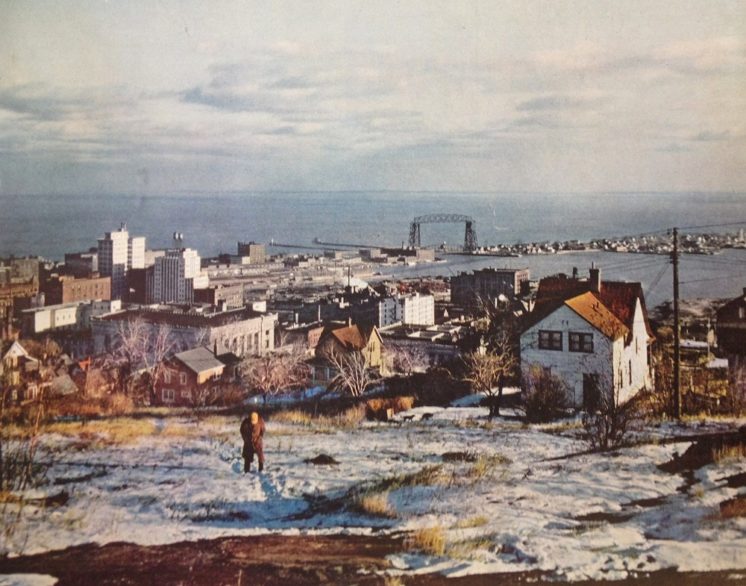
A view of downtown Duluth bordered by its beloved Lake Superior. The city’s famous aerial-lift bridge is seen in the background.
Originally the aerial-lift bridge was not exactly a bridge, but a high arch from which was suspended a sort of basket which traveled back and forth with passengers and vehicles across the open canal. It is now one of the fastest vertical-lift bridges in existence, rising to its full height of 138 feet in less than a minute. It is so delicately counterbalanced that when snow or sleet adds to its weight, the matter is adjusted by tucking concrete blocks into small pockets in the counterweights. Duluth eyes are often on the bridge. To strike a rough average, there is a vessel moving through the canal every twenty minutes of the season, night and day, and according to the Army Corps of Engineers, which has jurisdiction over the port, bulk freighters of the Great Lakes haul more than twice the normal tonnage of all the rest of the United States merchant fleet combined. The cargo record is 20,634 short tons in a single ship. At the record loading speed, this ship could have been loaded in less than one hour.
Traffic beneath the bridge will pass very close to a spot where, a little more than two decades ago, Duluth made rowing history. The Duluth Boat Club produced Walter Hoover, who won the world’s single-sculls championship in 1922, and so-called “iron-man” crews of four and eight made records thirty years ago that still stand. Chief sponsor of the boat club in those days was Julius H. Barnes, who was United States Wheat Director in the late years of Woodrow Wilson’s Administration, and whose name is still on a trophy for which oarsmen in national meets compete today. Barnes, however, dropped out of grain and the boat club at about the same time, and turned to shipbuilding. Today he is president of the National St. Lawrence Association and is Duluth’s most fervent proponent of a seaway from the Lakes to the Atlantic.

Duluth ships huge quantities of grain and ore via the Great Lakes; the port’s annual tonnage is exceeded only by New York’s.
Barnes was an early associate of Capt. Alexander McDougall, who built ships that older residents in the Great Lakes region will remember very well. Called whalebacks, they had pointed prows and rounded sides, and quickly earned the name “pigboat” from sailors. Most famous of the breed was the Christopher Columbus, built for passenger cruises from the World’s Columbian Exposition in Chicago in 1893.
The whalebacks eventually gave way to the straight-sided, shallow-draft, flat-bellied ore boats of today. Barnes built similar adaptations of the whaleback, some of which got out into the oceans. But only those shorter than 255 feet could get through the Welland Canal from Lake Erie into Ontario, and Barnes, who wanted to build ocean-going ships larger than this, was aroused to greater indignation than most people by the bottleneck in the St. Lawrence outlet. All Duluthians, peering under the skeletal outlines of their precious lift bridge, can visualize ocean vessels steaming off to distant continents, and incidentally making Duluth an exit port for all the Northwest down to Omaha, Nebraska.
Of course, within the 255-foot limit, Duluth is already a seaport. Four Swedish vessels visited Duluth last season, bringing English motorcars and lutefisk, taking back farm wagons and merchandise. Once a Swedish ship brought wood pulp for a paper plant near Duluth at a price cheaper than the wood pulp from the surrounding forests, which gave the city a sharp lesson in the two-sidedness of foreign trade. Nevertheless, Duluth yearns so passionately for a St. Lawrence seaway that it has been called “an old maid city looking under its bed every night for an ocean.” The only good thing Duluthians can see in the development of iron ore in Labrador is that it might help open the lake to deep-water traffic.
Probably no other city so far inland has ever seriously contemplated big ocean vessels at its door. Duluth is 2329 miles from Belle Isle Strait at the mouth of the Gulf of St. Lawrence. At that point a ship for Liverpool would have less than half its trip remaining, a mere 1898 miles. The total of these two legs, it is apparent, is 4227 miles, which catches the erroneous Proctor Knott in another of his wrongful Duluthisms. Knott said it was 3990 miles from Duluth to Liverpool, and summed up his opinion of the city’s substance in 1871 by adding, “though I have no doubt, for the sake of convenience, it may be moved back ten miles so as to make the distance an even four thousand.”
It was that kind of crack that built Duluth.
Recommended Links:
Leave a Comment
Only registered members can post a comment , Login / Register Here


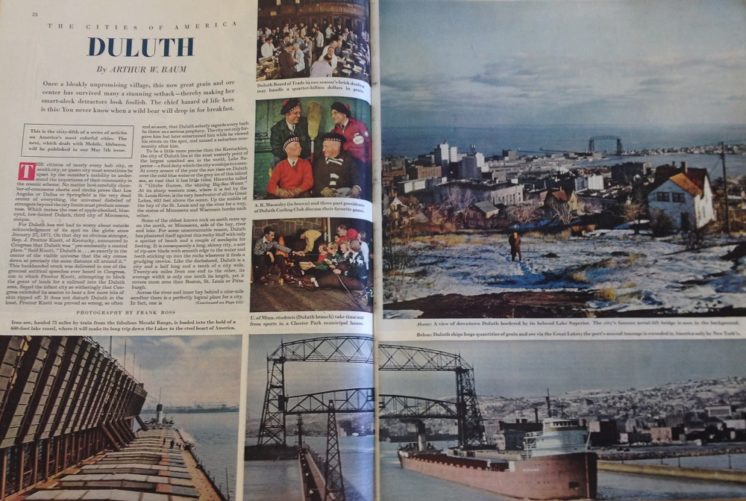
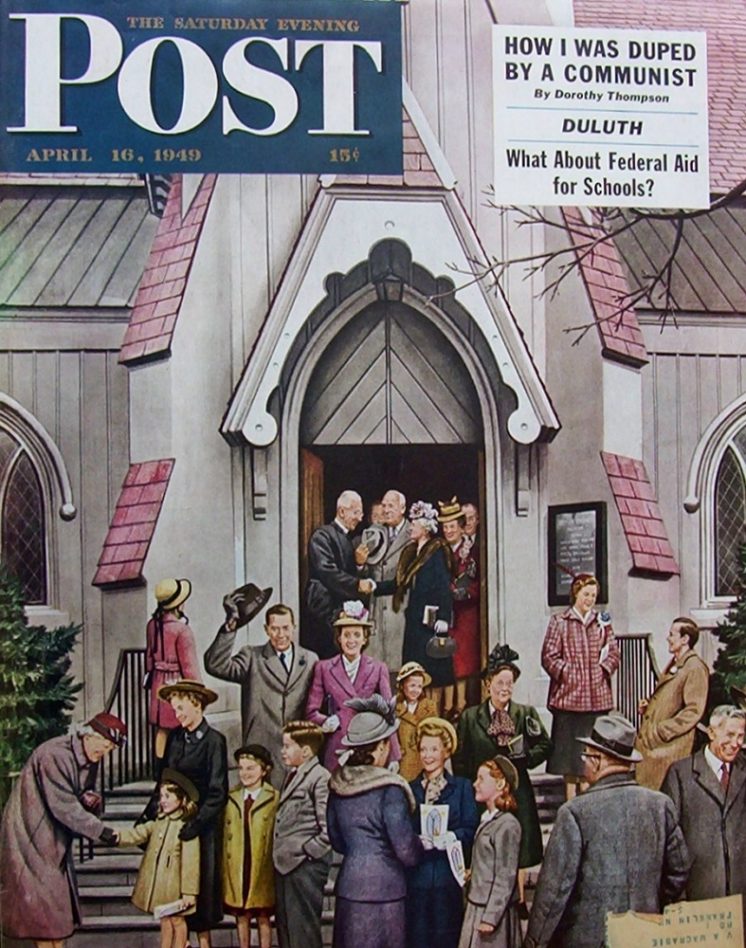
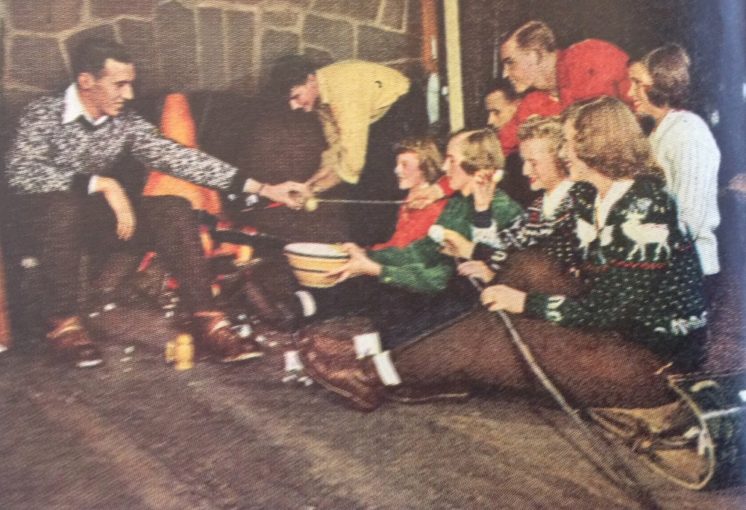
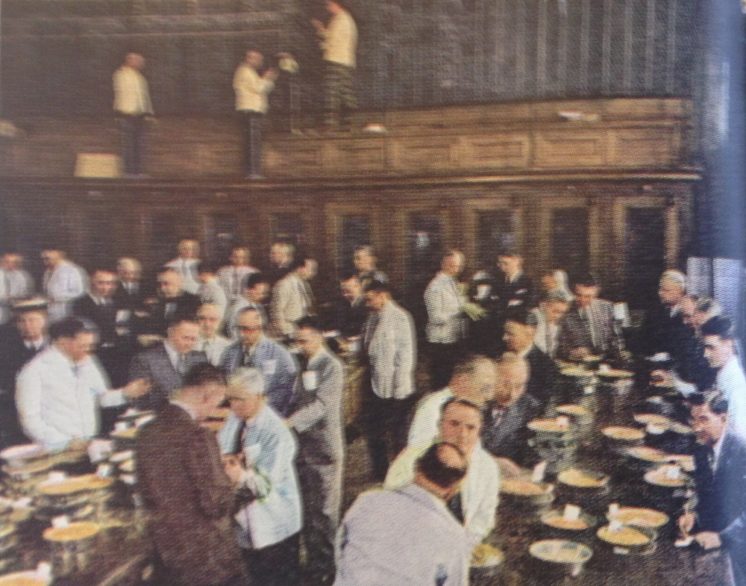
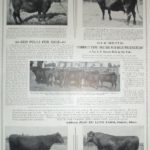
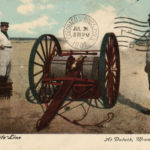
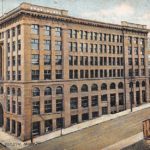
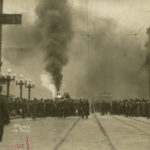








10 Comments
Harry Welty
about 6 years agodulutherati
about 6 years agoPaul Lundgren
about 6 years agoMatthijs
about 6 years agoDoug
about 6 years agoDECk37
about 6 years agoDECk37
about 6 years agoGina Temple-Rhodes
about 6 years agoKarl Ulrich
about 6 years agoPaul Lundgren
about 6 years ago